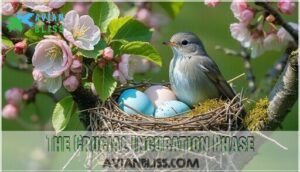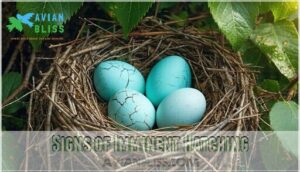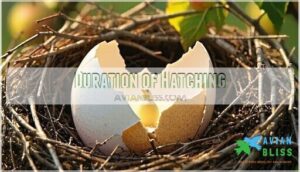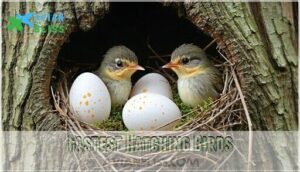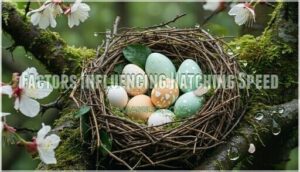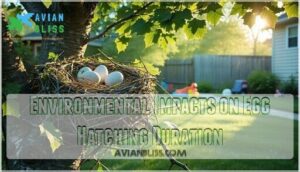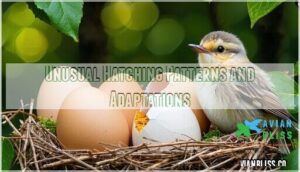This site is supported by our readers. We may earn a commission, at no cost to you, if you purchase through links.
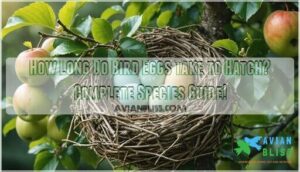
What affects how long this takes? Three main things: how big the bird is, plus temperature and humidity.
Bigger birds need more development time, and weather conditions can speed things up or slow them down quite a bit.
Table Of Contents
- Key Takeaways
- Bird Egg Incubation: a Comprehensive Timeline
- From Nest Building to Egg Laying
- The Crucial Incubation Phase
- Variations in Hatching Times Across Bird Species
- Environmental Impacts on Egg Hatching Duration
- Egg Development: From Fertilization to Hatchling
- Parental Care During and After Hatching
- Unusual Hatching Patterns and Adaptations
- From Egg to Fledgling: Post-Hatching Development
- Frequently Asked Questions (FAQs)
- How long do birds sit on their eggs before they hatch?
- How long does it take for baby birds to leave their nest?
- How long does it take for an egg to hatch naturally?
- Can I move a bird nest with eggs?
- Do bird eggs experience developmental delays during incubation?
- Can bird eggs hatch without incubation?
- What happens to unfertilized bird eggs?
- Do all eggs in clutch hatch simultaneously?
- Can cracked bird eggs still hatch successfully?
- How do you identify if eggs are viable?
- Conclusion
Key Takeaways
- Incubation periods vary dramatically by species size – Small songbirds like sparrows and finches hatch in just 11-17 days, while larger birds like ducks need 28-35 days, and eagles can take up to 45 days.
- Temperature is the most critical factor affecting hatching time – Eggs develop fastest between 99-101°F, and even small temperature changes of just 1.7°C can shorten or extend the hatching process by several days.
- Most backyard birds fall into a predictable 2-3 week window – Common species you’ll encounter typically hatch within 14-21 days, making this the most useful timeframe for backyard bird watchers.
- Environmental conditions can significantly alter expected timelines – Factors like humidity levels, predator presence, and weather patterns can speed up or slow down incubation, so the ranges provided are estimates rather than exact schedules.
Bird Egg Incubation: a Comprehensive Timeline
Bird egg incubation times vary dramatically across species—tiny songbirds hatch in just 10-14 days while massive albatrosses need up to 80 days.
These timing differences reveal the incredible diversity in how birds reproduce and the unique strategies each species has evolved for raising their young.
Average Incubation Periods for Common Species
Across avian species, incubation periods vary dramatically based on bird size and evolutionary adaptations. Here are common Species Incubation Ranges you’ll encounter:
- Small songbirds (11-17 days) – American Goldfinch and House Sparrow both require 13 days
- Poultry Incubation Periods (21-28 days) – Chickens hatch at 21 days, turkeys at 28 days
- Waterfowl Hatching spans 28-35 days for ducks, with geese taking 28-33 days
- Raptor Incubation Length ranges widely – American Kestrels need 28-30 days while Golden Eagles require 41-45 days
- Large ratites show extreme hatch duration – Kiwi eggs incubate 74-90 days
Understanding these average hatch duration patterns helps you predict when different bird species will welcome their young. The process of bird egg incubation is influenced by ambient temperature and humidity.
Factors Affecting Incubation Duration
Beyond nest location, several key factors determine your bird eggs’ incubation timeline. Temperature variability plays the biggest role—embryos develop fastest between 99–101°F, with just 1.7°C changes shortening or extending hatching by days. Slight temperature changes can also impact the embryonic development process.
Here’s the thing about humidity—anywhere from 25–93% works fine for hatching success, but it does shape how healthy your chicks turn out.
Stress from predators or disturbances can actually speed things up, pushing embryos to develop faster.
And if you’ve got a bigger clutch? Expect to wait longer since the parents are juggling more eggs.
| Factor | Fast Hatching (10–14 days) | Slow Hatching (60–80 days) |
|---|---|---|
| Egg Size | Small songbird eggs | Large seabird eggs |
| Temperature | Consistent 99–101°F | Variable, cooler climates |
| Clutch Size | 2–4 eggs typical | Single egg focus |
| Environment | Protected nests | Exposed, harsh conditions |
| Species | Robins, finches | Albatrosses, penguins |
Parental Roles During Incubation
Picture this: while you’re fast asleep, bird parents are working around the clock like dedicated nurses, taking turns to keep their eggs at perfect temperatures. It’s a beautiful partnership that creates some pretty amazing parenting strategies.
While you sleep, bird parents work around the clock taking temperature-regulating shifts to keep their eggs perfectly warm
Most birds share this egg-sitting duty through carefully timed shifts:
- Females handle most incubation in many species, while males play food delivery service during mom’s breaks
- Males take the lead in species like phalaropes, where traditional roles flip completely
- Tag-team incubation can mean anything from hourly switches to full day-long shifts
- Active nest management includes regularly turning eggs and fine-tuning positions for optimal warmth
This tag-team approach keeps eggs at steady temperatures around the clock, ensuring successful hatching.
Egg Development Stages
Inside every bird egg, a striking transformation unfolds as a single cell becomes a complex creature ready to break free into the world. During embryonic development, specialized embryonic membranes protect the growing chick while yolk composition provides essential nutrients. Shell formation begins thinning near hatching as albumen development aids chick growth through key avian embryology stages.
- Watch tiny hearts beat after just 72 hours of incubation
- Feel amazed as feathers form beneath translucent shells
- Witness nature’s miracle as beaks break through protective barriers
From Nest Building to Egg Laying
Think of nest building as nature’s version of house hunting – except the stakes are life and death, and there’s no real estate agent to help you out. Birds must consider predator threats, weather protection, and food access during Nest Site Selection. They’re remarkably picky about location – robins prefer sturdy tree forks while ground-nesters like killdeer choose open areas with good visibility.
Material Gathering comes next. Birds collect everything from twigs and grass to spider webs and moss. Nest Construction varies dramatically between species – some weave intricate baskets while others scrape simple depressions.
| Species | Nest Type | Construction Time | Materials Used | Laying Frequency |
|---|---|---|---|---|
| Robin | Cup-shaped | 2-6 days | Twigs, mud, grass | 1 clutch/season |
| Wren | Dome | 7-10 days | Twigs, moss | 2-3 clutches/season |
| Eagle | Platform | 1-3 months | Sticks, branches | 1 clutch/season |
| Hummingbird | Tiny cup | 6-10 days | Plant down, spider silk | 2-3 clutches/season |
| Killdeer | Scrape | 1 day | Pebbles, shells | 1-2 clutches/season |
Once nesting wraps up, Egg Formation begins internally. Most birds start egg laying within days, with first lay dates varying by species and egglaying month influenced by climate and food availability.
The Crucial Incubation Phase
Once your birds have laid their eggs, the real work begins with incubation – a delicate balancing act that determines whether those eggs will successfully hatch.
During this critical phase, parent birds must carefully regulate temperature, control humidity levels, turn eggs regularly, and maintain their nest to give their developing chicks the best chance at life.
Temperature Regulation
Birds have mastered temperature control during incubation through clever physical adaptations. They develop a special brood patch—basically a bare spot on their belly where feathers fall away—that acts like a natural heating pad for direct contact with eggs.
These feathered parents constantly adjust their position and behavior as conditions change. Hot day? They might lift slightly to let air circulate. Cold snap? They settle down closer for maximum warmth transfer. It’s all about reading the environment and responding.
As hatching time approaches, this temperature regulation becomes even more critical. The final days require steady, precise warmth to help chicks develop properly.
Modern incubators try to copy what birds do naturally, using controlled heat and careful monitoring to replicate millions of years of evolutionary fine-tuning.
Humidity Control
Getting humidity wrong can spell disaster for developing chicks—too little moisture and they’ll stick to their shells like glue, too much and deadly mold takes over. Most birds instinctively create ideal humidity through careful nest construction and body positioning during incubation.
| Species | Ideal Humidity | Incubation Temperature | Environmental Factors |
|---|---|---|---|
| Chickens | 55-60% | 99.5°F | Stable indoor conditions |
| Robins | 50-55% | 98-100°F | Natural nest materials |
| Eagles | 60-65% | 99-101°F | High altitude adaptations |
| Penguins | 70-80% | Variable | Extreme cold environments |
You’ll notice successful hatching depends on precise humidity measurement throughout the entire incubation period, with incubator settings requiring daily monitoring for embryo development success.
Egg Turning and Positioning
Getting the humidity right makes all the difference—mess it up and you’ll watch chicks struggle to break free from their shells or see mold destroy everything you’ve worked for.
Check your incubator daily because even small changes can make or break the whole process.
Birds perform an ancient dance on their eggs, rotating them dozens of times each day in a careful choreography that means the difference between life and death for their developing chicks. Without proper egg turning, embryos stick to shell membranes and die. This instinctive behavior prevents embryo adhesion while promoting even development.
Here’s how birds master this important process:
- Turning Frequency – Most species rotate eggs 24-48 times daily during incubation time
Birds perform an ancient dance on their eggs, rotating them dozens of times each day in a careful choreography that means the difference between life and death for their developing chicks. Without proper egg turning, embryos stick to shell membranes and die. This instinctive behavior prevents embryo adhesion while promoting even development.
Here’s how birds master this important process:
- Turning Frequency – Most species rotate eggs 24-48 times daily during incubation
- Ideal Angle – Birds tilt eggs 45-90 degrees to prevent membrane sticking
- Manual Rotation – Parent birds use beaks and feet for precise positioning
- Automated Turning – Some cavity nesters rely on body movements for consistent rotation
All that careful rotation? It makes or breaks hatching success across every bird species.
While eggs develop inside their protective shells, dedicated bird parents become master architects, constantly upgrading and reinforcing their nests to weather any storm.
You’ll watch them perform essential nest sanitation by removing eggshell fragments and waste. They expertly handle material replacement, weaving fresh twigs and leaves to maintain structural integrity.
These nesting birds also focus on predator defense, strategically positioning themselves while controlling the nest’s microclimate for best avian incubation success.
Eggs develop inside their protective shells while parent birds become master architects, constantly upgrading and reinforcing their nests to weather storms.
You’ll see them perform essential nest sanitation by removing eggshell fragments and waste. They handle material replacement with skill, weaving fresh twigs and leaves to maintain structural integrity.
Parent birds stay vigilant against predators, positioning themselves strategically. They also control the nest’s microclimate to ensure optimal incubation conditions.
After weeks of careful incubation, the hatching process marks the dramatic finale of egg development.
You’ll witness a carefully orchestrated sequence as chicks break free from their calcium carbonate prison, often taking 12 to 48 hours from the first crack to complete emergence.
Signs of Imminent Hatching
You’ll notice subtle changes in your eggs about 24 to 48 hours before the chicks break free—small cracks appearing like tiny lightning bolts across the shell, soft peeping sounds from within, and gentle rocking movements that signal new life is ready to emerge. The pipping process begins with these clear indicators:
- Shell weakening creates visible hairline fractures as the chick’s egg tooth works against the calcium carbonate structure
- Egg sounds intensify from faint chirps to distinct peeping as hatchlings communicate with parents
- Chick movement becomes pronounced, causing the entire egg to wobble and shift position in the nest
Watch for changes in parental behavior too—adult birds often become more attentive and vocal as they sense their offspring preparing to hatch.
Duration of Hatching
Once the internal pip occurs, you’re looking at a marathon, not a sprint. Hatching timeframes stretch from 12 to 48 hours for most species, though temperature influence and environmental factors can extend this process.
Small songbirds usually complete their escape in 12-24 hours, while larger species like ducks may take the full 48 hours to break free completely.
Assistance From Parents
When those tiny beaks start pecking through the shell, devoted bird parents transform into gentle midwives, ready to guide their babies into the world. Their parental roles in incubation extend beyond maintaining temperature during the incubation period.
You’ll witness striking assistance through:
- Vocal communication – Soft calls encourage chicks during hatching
- Shell fragment removal – Parents carefully clear debris to prevent injury
- Nest sanitation – Immediate cleanup maintains a healthy environment
- Chick defense positioning – Strategic placement protects vulnerable hatchlings
This imprinting behavior strengthens the parent-chick bond while guaranteeing successful avian reproduction.
Variations in Hatching Times Across Bird Species
These early bonding moments create lasting connections between parents and chicks, setting the stage for successful breeding cycles.
Bird species show striking differences in how long their eggs take to hatch, with some taking just 10 days while others need over two months.
Understanding these variations helps you know what to expect whether you’re watching wild birds or incubating eggs yourself.
Fastest Hatching Birds
Speed is important for rapid incubation among bird species. House Wrens lead the pack with eggs hatching in just 9 days, while Black-billed Cuckoos follow at 11 days.
Climatic influence plays a key role—warmer temperatures can shorten the bird egg incubation period by half a day per degree.
Geographic variation also affects hatching time for bird eggs, with northern populations often experiencing faster development due to nesting behavior adaptations and physiological constraints that improve incubation time for bird eggs.
Slowest Hatching Birds
Some species push incubation time to considerable extremes. Albatross incubation can stretch beyond 80 days, with wandering and royal albatross leading this marathon. Megapode strategies involve burying eggs in mounds for 50-70 days. Kiwi development requires 75-85 days due to their massive egg size.
Cassowary nesting lasts around 50 days, while other tropical ground-nesters like mallee fowl extend incubation periods substantially.
Factors Influencing Hatching Speed
Ever wonder why some bird eggs seem to take forever while others hatch in the blink of an eye? Several factors affecting bird egg incubation determine hatching speed:
- Temperature Effects: Warmer conditions accelerate development, while cooler temperatures slow incubation periods
- Humidity Levels: Ideal moisture prevents dehydration and fosters proper embryonic growth
- Predation Risk: Species in high-risk environments evolved shorter incubation times for survival
- Climate Change: Shifting weather patterns increasingly impact traditional hatching schedules
Environmental Impacts on Egg Hatching Duration
Your bird’s eggs don’t hatch in a vacuum—they’re constantly responding to the world around them. Temperature swings, lurking predators, and even your backyard activities can speed up or slow down the hatching timeline in ways that might surprise you.
Climate and Weather Effects
Mother Nature throws curveballs that can make or break your egg-watching timeline. Temperature impacts hit hardest—every degree Celsius increase speeds up incubation by roughly 1.4 days within the 6-14°C range. Humidity influence works differently, with levels below 40% extending hatching by over a day due to excessive water loss. Wind exposure above 5 meters per second increases heat loss by 22%, while solar radiation can boost nest temperatures by 4°C, shortening incubation nearly a full day. Climate change and seasonal trends now account for 18% of yearly hatching variations.
Environmental Factor Ideal Range
Predator Presence
Predators don’t just threaten eggs—they can actually speed up the entire hatching process as birds race against time to get their vulnerable offspring out of harm’s way. This predator detection triggers shortened incubation periods as survival instincts kick in.
Environmental influences on bird egg incubation include:
- Hawks circling overhead, causing ground-nesting birds to increase brooding frequency
When predators lurk nearby, something remarkable happens—birds actually speed up their entire hatching timeline. It’s like nature’s emergency protocol kicks in, shortening incubation periods as parents race to get their babies out of danger.
You’ll see this play out in different ways depending on what’s threatening the nest. Hawks circling overhead make ground-nesting birds brood more frequently, their instincts telling them to stay close. When snakes show up near cavity nesters, the hatching success rates jump as birds push their timing forward. Even raccoon tracks around a nest site trigger parents to amp up their defense behaviors, while cat activity in the area creates enough stress to actually reduce the normal incubation period.
All these camouflage strategies and vulnerability factors work together, creating this intricate dance where hatching times shift based on threat levels.
Sometimes the biggest threat to a bird’s nest isn’t a snake or hawk—it’s you walking by with your morning coffee. Human disturbances create stress that affects incubation success through habitat loss and direct interference. Climate change compounds these challenges, making conservation efforts vital:
- Noise pollution disrupts normal incubation behaviors
- Light pollution alters natural feeding and nesting cycles
- Foot traffic forces parents to abandon eggs temporarily
Egg Development: From Fertilization to Hatchling
Bird egg development follows a fascinating timeline from fertilization to hatching. You’ll witness extraordinary transformations as tiny embryos grow into fully formed chicks ready to break free from their shells.
Formation of Embryonic Structures
Inside a bird egg, nature orchestrates one of its most extraordinary transformations as a single fertilized cell rapidly divides and reorganizes into the foundation of a future hatchling.
During embryonic cell division, three essential germ layer formations emerge—ectoderm, mesoderm, and endoderm—each destined to create specific body systems.
Organogenesis stages follow as notochord development establishes the backbone framework, while the protective amniotic sac forms around the developing chick embryo.
Growth of Feathers and Limbs
Watching feathers and limbs take shape inside a developing bird egg is like witnessing nature’s most intricate construction project unfold in fast-forward. During embryo development, you’ll see striking transformations:
- Feather bud development begins around day 7-10, creating tiny bumps that eventually become downy protection
- Limb bud formation starts early, with paddle-like wings and legs gradually developing joints and digits
- Bone growth and muscle development work together, strengthening structures for hatchling mobility
Most chicks achieve functional feathers and limbs within their species’ incubation period.
Development of Internal Organs
While you can watch feathers sprouting and tiny legs taking shape, the real magic happens deep inside the egg where a bird’s essential organs are quietly assembling themselves into a functioning life-support system.
The heart forms first, pumping embryonic blood flow through developing vessels. Your chick’s nervous system follows precise genetic control patterns, with cellular differentiation creating specialized tissues.
This organ development timeline unfolds systematically during embryonic development, transforming simple cells into complex organ system formation that sustains life.
Parental Care During and After Hatching
Once your eggs hatch, the real work begins as parent birds shift into full-time caregiving mode.
You’ll see them constantly feeding hungry chicks, maintaining perfect nest temperatures, and keeping everything spotlessly clean for the vulnerable newborns.
Each organ develops on its own schedule during those crucial weeks, with simple cells gradually specializing into the intricate systems that keep a bird alive.
Those tiny mouths open every few minutes, like hungry little flowers reaching for the sun, and parent birds work tirelessly to keep up with their insatiable appetites. Altricial chicks demand constant attention, while precocial types can nibble independently. Both parents share feeding duties, bringing insects, worms, or regurgitated food every 15 to 20 minutes during daylight hours.
Key feeding essentials for newly hatched avian chicks:
- Feeding frequency: Every 15-20 minutes from dawn to dusk
- Chick diet: High-protein insects, worms, and caterpillars for rapid development
- Parental involvement: Both parents alternate hunting and feeding duties
- Food types: Species-specific nutrition like seeds for finches, fish for seabirds
- Hydration needs: Moisture comes from food rather than direct water consumption
This intensive chick development phase requires tremendous energy from parents as they fuel their offspring’s striking growth.
Brooding and Temperature Regulation
Think of newly hatched chicks as tiny furnaces that can’t regulate their own temperature—they depend entirely on their parents’ warmth to survive those critical first hours. Parent birds develop a specialized brood patch during the bird egg incubation period, losing feathers on their belly to create direct skin contact. This nest thermoregulation system maintains ideal temperature through coordinated brooding shifts.
| Species | Brooding Duration | Temperature Range |
|---|
Raising baby birds is exhausting work. Parent birds burn through massive amounts of energy as they watch their chicks grow at an incredible pace.
Nest Sanitation
Imagine this: your feathered tenants have turned their cozy nest into what looks like a disaster zone after a particularly messy dinner party. Parent birds tackle nest hygiene through constant waste removal and parasite control. They replace soiled nest materials with fresh twigs and leaves, while some species add antimicrobial plants for disease prevention – important factors affecting bird egg incubation success.
- Remove fecal sacs immediately to prevent bacterial growth
- Replace contaminated nesting materials with fresh vegetation
- Add aromatic herbs like mint or lavender for natural pest control
- Inspect regularly for mites, lice, and other parasites threatening chick health
Unusual Hatching Patterns and Adaptations
Not all birds follow the typical hatching timeline you might expect. Some species have developed fascinating strategies like staggered hatching, where eggs don’t all hatch at once, while others rely on sneaky tactics like laying their eggs in other birds’ nests.
Asynchronous Hatching
Not all bird siblings get a fair start in life—some eggs deliberately hatch days apart, creating a natural pecking order that can mean the difference between survival and starvation.
This hatching spread creates intense sibling competition where earlier chicks dominate food access. Parents invest more in stronger offspring, while weaker siblings face reduced survival odds.
This evolutionary advantage helps at least some chicks survive harsh conditions through strategic hatch timings and species variation.
Brood Parasitism
Nature’s most cunning freeloaders have mastered the art of deception. Brood parasites like cuckoos and cowbirds dump their eggs in unsuspecting hosts’ nests, forcing them to raise alien chicks. This coevolutionary arms race has produced striking parasite specialization and host defenses over millions of years.
- Parasite Evolution – About 100 bird species exploit over 1, 700 host species worldwide
- Host Impact – Parasitized nests show 58% reduced fledging success for host young
When conditions get tough, this timing trick gives parents their best shot at raising survivors—even if it means some chicks get left behind.
- Defensive Adaptations – Some hosts recognize foreign eggs and eject them from nests
Extended Incubation in Some Species
Some birds take their sweet time in the egg, stretching incubation periods to marathon lengths that would make most parents dizzy with anticipation. These extreme incubation champions have evolved delayed hatching strategies for survival in harsh environments.
The Royal Albatross holds the record for avian biology’s longest wait:
- Emperor Penguin: 64 days of Antarctic incubation period endurance
- Royal Albatross: 79-day hatch duration in oceanic conditions
- Kiwi: 75-day incubation influenced by large egg size
Factors influencing hatch duration include body size, environmental conditions, and evolutionary adaptations that prioritize chick development over speed.
From Egg to Fledgling: Post-Hatching Development
Once your bird eggs hatch, the real adventure begins as tiny hatchlings transform into independent fledglings ready for their first flight.
The post-hatching development period varies dramatically between species, with some birds leaving the nest in just days while others need weeks of parental care before they’re ready to explore the world on their own.
Growth Rates of Different Bird Species
After your chicks break free from their shells, you’re in for quite a show as growth rates vary dramatically across bird species. Small songbirds can double their weight daily during peak post-hatch development, while larger raptors grow more steadily over weeks.
Growth rate factors include nutritional impact from parental feeding, environmental influence like temperature, and genetic predisposition. This variability directly correlates with average hatch duration patterns you observed earlier.
Feather Development and First Flight
From fuzzy down to aerodynamic refinement, your fledgling is about to transform into a flying machine right before your eyes. This notable avian development unfolds through distinct Feather Growth Stages, where downy fluff gives way to a complex flight apparatus. Flight Muscle Development occurs simultaneously, strengthening the pectorals that power wing beats.
Your hatchlings experience different learning curves depending on whether they’re precocial or altricial young. The Fledgling Learning Curve varies dramatically between species:
- Pin feathers emerge first, creating the structural foundation for flight capabilities
What drives these growth differences? It comes down to three main things: how much food the parents can bring back to the nest, whether the weather’s been kind or harsh, and what the chicks’ DNA has programmed them for.
These same factors that shape how fast chicks grow also explain why some eggs take longer to hatch than others.
- Primary flight feathers unfold last, enabling lift generation and directional control
- Wing-flapping exercises begin, building essential muscle memory before First Flight Success
Bird egg development stages culminate in this critical phase where Types of bird chicks master coordination. Post-Fledging Care from parents continues even after initial flight attempts, securing survival during this vulnerable shift period.
Time to Leave The Nest
Just when you think your fledglings are ready to take on the world, they surprise you with how long they actually stick around the nest. Altricial birds like robins need 13-16 days before fledgling independence begins, while precocial birds gain survival skills within hours.
Post-fledgling care continues as parents guide nest abandonment timing, balancing parental investment with teaching essential avian development milestones that help hatchlings survive their shift to independence.
Even after leaving the nest, young birds aren’t quite ready to go it alone. Parents keep teaching them the ropes—showing them what to eat, where to find it, and how to spot danger.
It’s a delicate dance between letting go and making sure their kids have what it takes to make it on their own.
Frequently Asked Questions (FAQs)
How long do birds sit on their eggs before they hatch?
Behind every chirp and flutter lies a carefully timed biological countdown. Most birds maintain constant incubation periods ranging from 10-80 days depending on species variation.
Small songbirds complete their hatch duration in just two weeks, while larger species like eagles require over a month of dedicated parental care for successful hatching.
How long does it take for baby birds to leave their nest?
Most hatchlings develop into fledgling independence within 2-3 weeks, though species variation affects nest departure cues.
Precocial young leave sooner than altricial hatchlings, which require extended parental dependency and post-fledging care before achieving true independence.
How long does it take for an egg to hatch naturally?
Surprisingly, natural incubation length varies dramatically across species. Your typical backyard songbird eggs complete their incubation period in just 10-14 days, while larger species require considerably longer hatching time for bird eggs.
Environmental hatch influence and parental incubation roles determine this critical development timeline.
Can I move a bird nest with eggs?
Moving a bird nest with eggs isn’t recommended—and it’s often illegal. The Migratory Bird Treaty Act prohibits moving active nests containing eggs or chicks, making nest relocation legality a serious concern. Even well-intentioned efforts create significant egg abandonment risk as stressed parent birds may desert their nesting attempts.
Here’s what you need to know about safe moving distance and alternatives:
Bird eggs take wildly different amounts of time to hatch. Your backyard robins and sparrows wrap up the whole process in about 10-14 days, but bigger birds need way more time to get their chicks ready for the world.
How long this takes really comes down to two main things: what’s happening in the environment around the nest and how the parents handle their incubation duties.
- Best relocation timing – Wait until after the breeding season when nests are naturally empty
- Safe distance – Maintain at least 15 feet from active nests to avoid disrupting parental care
- Alternative solutions – Create barriers around the nest area or postpone nearby activities until hatching completes
Your conservation efforts are better served by protecting nests in place. If the situation is truly dangerous, contact local wildlife authorities who can assess whether relocation permits are justified. Remember that successful bird eggs depend on consistent temperature and minimal disturbance throughout their development.
Do bird eggs experience developmental delays during incubation?
Like a delicate clock that can slow down when winds shift, bird eggs can experience developmental delays during incubation due to temperature fluctuations, humidity effects, and genetic factors.
Embryos respond to cold stress by slowing heartbeat rates and metabolism, sometimes entering torpid-like states before extending their incubation period to compensate.
Can bird eggs hatch without incubation?
Without proper incubation, bird eggs won’t hatch naturally. Egg development requires consistent warmth and humidity that only dedicated parental care or artificial incubation can provide.
Here are key factors affecting Unattended Egg Viability:
- Environmental Hatching Factors – Temperature must stay within 99-102°F consistently for successful egg development and hatching
- Natural Heat Sources – Decomposing vegetation or warm sand can occasionally provide adequate heat, but rarely maintains proper conditions
- Alternative Incubation Methods – Artificial incubation equipment replicates parental care with precise temperature and humidity control
- Hatching Success Rates – Eggs without incubation have nearly zero survival rates due to embryonic development failure
What happens to unfertilized bird eggs?
You might wonder if unfertilized avian eggs simply vanish into thin air. They don’t.
Unfertilized eggs undergo a natural decomposition process, attracting predators seeking nutritional value. Parents abandon nests after recognizing failed fertility through careful egg identification and development assessment.
Do all eggs in clutch hatch simultaneously?
While birds appear to time everything perfectly, hatching synchronicity varies dramatically across bird species. Most clutches don’t hatch simultaneously due to different factors affecting each egg’s development timeline.
- Clutch hierarchy – Earlier laid eggs often hatch first, creating size advantages
- Resource allocation – Parents invest differently in each egg based on environmental conditions
- Hatching window – Most species show 1-3 day variability within clutch size
- Parental investment – Some bird species deliberately stagger hatching to get the most out of hatchling survival during challenging periods
This hatch duration variability ensures stronger hatchlings can compete effectively for limited parental care and food resources.
Can cracked bird eggs still hatch successfully?
Why worry about a hairline crack when you can still save your feathered friend? Cracked eggs can hatch successfully if the membrane remains intact and shell integrity isn’t severely compromised.
However, membrane damage risk increases infection vulnerability and reduces hatching success rates, making proper egg handling and storage essential for best hatch rates.
How do you identify if eggs are viable?
You can determine egg viability through candling techniques using bright light to check embryo development and air cell size. Fertile eggs show blood vessels and dark spots during candling, indicating healthy fertility signs and proper egg development.
The float test reveals density changes, providing additional insights into egg viability.
Conclusion
Understanding how long bird eggs take to hatch reveals nature’s striking timing precision. Each species has evolved specific incubation periods that match their survival needs. Small songbirds rush development in just 11–17 days, while larger raptors invest 45+ days in building stronger offspring.
Temperature, humidity, and parental dedication all influence these timelines. Whether you’re watching backyard robins or studying eagles, remember that patient observation rewards you with witnessing one of nature’s most fascinating transformations.
- https://aaacwildliferemoval.com/blog/birds/the-gestation-period-of-birds/
- https://chirpforbirds.com/wild-bird-resources/the-bird-egg-cycle/
- https://ornithology.com/ornithology-lectures/development-birds/
- https://incubatorwarehouse.com/pages/how-long-to-hatch-an-egg
- https://www.reddit.com/r/Ornithology/comments/o3yclh/how_long_do_birds_gestate_their_eggs_before/


